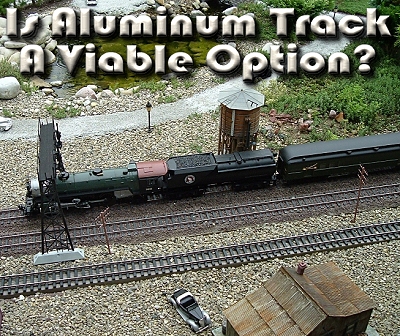 | |||
 |  |
 | |
 |
 | ||
 |
 | ||
 |  | ||
 |  | ||
 | |||
 |  |
 | |
 |
 | ||
 |
 | ||
 |  | ||
 |  | ||
Written by Paul D. Race for Family Garden Trains(tm)
 and
Garden Train Store(tm) and
Garden Train Store(tm) |


| Is Aluminum Track a Viable Option?Since the advent of modern garden railroading, we have assumed that our trains would run on sturdy brass rails. In fact, LGB made their rails as large as they could be without looking silly, so that the track would be as strong as possible. (LGB rails are "Code 332" which means that they are almost 1/3" high - think "thousandths of an inch" when you see a rail's Code value.) Most other manufacturers followed suit, including AristoCraft, who used the same size rails but added screw-on track and power connections that made their track much more conductive and reliable in the long run. Early Aluminum ExperimentsA few companies, such as Llagas Creek, began making track with aluminum and smaller track profiles, such as Code 250 (about 1/4" high). Many people used and liked it; some used it and weren't quite so thrilled, so it never quite caught on as it probably deserved. One factor was that the companies that could manufacture aluminum track cheaply didn't always have the resources to make turnouts (switches) cheaply, so the overall cost savings wasn't always what it should have been. Also, model railroaders and garden railroaders were used to the appearance of brass, which turned a realistic brown in a few years. Llagas Creek did offer aluminum rails that were prepainted brown, which helped, but the paint didn't always stay where it was supposed to. Still, it was a very nice look, and frankly, I like the look of Code 250 rail, but I don't always appreciate its weaker structure.Several friends who use Llagas Creek track in dry climates seem to like it. But some of my other friends experienced glitches. Aluminum Oxide Powder - One friend in the Dayton, Ohio area replaced his aluminum rails after several years with nickel silver. He runs long trains with all metal wheels - which would have kept brass track relatively clean. But apparently once the aluminum rails began oxidizing, the aluminum oxide dust generated by running trains would coat track, wheels, drivers, etc. to the extent that he couldn't run more than an hour between track cleanings. For folks who run mostly or only battery power, though, this is not a significant problem. Condensation - Aluminum draws heat from its surroundings so well that it is more prone to moisture condensing on the track in damp climates than brass or stainless, especially as the temperature drops around track that is on the ground. If your air quality is bad, the moisture will even feel a little "greasy." (Folks in dry regions never notice this problem; in fact one fellow from the American Southwest told me I was crazy for reporting it.) Some folks with small railroads in damp climates keep an old towel out to wipe off the track if it gets too wet. But some folks who run long trains have trouble with their locomotives slipping excessively on humid evenings (about the only kind we get during Ohio summers). Strength - Aluminum rail is not as strong as brass. My friend George Schreyer reminds me that if you step on aluminum rail it will bend over, even if it's on a very solid foundation. So if you use aluminum rail, it's a good idea to design your railroad in such a way that it's virtually impossible to step on the track. Not everyone has done that, unfortunately, and it is possible to lose your balance and take a mis-step, or for "helpful" friends to not pay attention . . . . Electrical Connections - People used to soldering electrical connections and jumpers to their rails discover quickly that the "rules" are different for soldering things to aluminum (it can be done, though). Issues of rail-to-rail connectivity have also been reported, though I'm not sure they're worse than on brass track with slide-on rail joiners (On the other hand, all of AristoCraft's track has features like screw-on rail joiners and power feed connections that should make this a non-issue, even with their aluminum track.) AristoCraft's Aluminum TrackAristoCraft, now out of business, offered aluminum track sporadically, mostly in Code 332. When the price of brass went through the roof, it seemed like a reasonable alternative. Unfortunately, they mostly made 48" circles and very short runs of several other configurations. Their aluminum track never really got a chance to prove itself before Aristo went out of business for other reasons. If you come across some, you'll find it useful, but you will have trouble getting enough to make anything but a loop around your Christmas tree. I have some of their 48" aluminum curves that I use with some 1' stainless-steel straights when I set up demo records. It works fine for that, but it's not a great option for most folks these days.Aluminum's Cost Advantage IncreasesWhen the cost of brass went through the roof in the early 2000s, aluminum track seemed lik a wiser option, especially for folks using battery or steam power. My friends with Llagas Creek track have been virtually unaffected by the whole track price jump thing.If you choose aluminum track,
ConclusionYou may have to draw your own - I admit that most of my examples of what worked and didn't work about aluminum track are "anecdotal," and your situation will be different. If I was building a railroad this year, especially if I lived in a drier climate, I'd consider starting with a loop or two of aluminum track just to see how it fares for me. If you are planning on using mostly or all battery-powered locomotives, that would be another point in aluminum's favor. On the other hand, if you live someplace with humid summers (like Dayton or Pittsburg), you plan on using track power, and you want the lowest maintenance track available, you might want to consider stainless steel, even if it means a smaller railroad at first.Me, I'm still using brass almost exclusively - I had enough Aristo brass track left over from when I was doing on-site clinics that I didn't really need to think about it until we moved and started a new railroad. Now I've had to replace some pieces, but not enough to rethink the whole thing. Please contact me with any feedback, corrections, additions, and/or personal abuse that you feel this article warrants, and I'll publish the bits that seem useful to our readers. Best of luck, Paul Race Reader FeedbackRichard Friedman, in Sacramento, California, writes:I've been using Llagas Creek code 250 aluminum with track power since the beginning (2001). Because it's code 250 and aluminum, it's not as robust at 332 brass, but it cuts easier. Aluminum is the second best conductor of electricity next to copper. Because of its light weight, it is often used in aircraft. It does need to be cleaned, but I've run trains for four hours or more before that became a problem. With a track cleaning caboose, that problem ended. The solution to electrolysis is simple (now)! I've used Hillman Clamps since I put the track down, and the brass and aluminum did cause problems. I now put heavy gauge aluminum foil around the rail and tighten the clamp. Electricity, being lazy, never goes into the brass. I've also used some of Hillman's stainless clamps. They seem to work fine. I have some Sunset Valley aluminum track, and while others have reported problems with the ties breaking off the rail, I haven't. It mates with Llagas Creek, and looks fine. I recommend aluminum because it's cheap, the smaller size looks great, and mine works fine. I live in Sacramento, CA, and get a foot of rain a year. The summer heat does not cause ME any kinking problems because much of the rr in in shade, and I've got very little absolutely straight track. Minimum radius is five feet, but use long gentle curves around the rest of the layout. Bradley Dobbins, in New Castle, Virginia, writes: On type of rail used, I have been using Peco Code 250 Nickel silver track indoors for some years with no problems (using DCC). I tried some of their aluminum rail track but contact was so poor, I am replacing this with NS and using the aluminum rail for guard rails . . . . |
|


| 
|
 |
 |
 |  |  |
Note: Family Garden TrainsTM, Garden Train StoreTM, Big Christmas TrainsTM, BIG Indoor TrainsTM, and BIG Train StoreTM are trademarks of Breakthrough Communications (www.btcomm.com). All information, data, text, and illustrations on this web site are Copyright (c) 1999, 2000, 2001, 2002, 2003, 2004, 2005, 2006, 2007, 2008, 2009, 2010, 2011, 2012, 2013 by Paul D. Race. Reuse or republication without prior written permission is specifically
forbidden.
For more information, please contact us |
 |  |